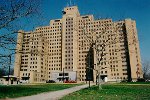New York State Office of Mental Health
Lighting Retrofit Plan
 The New York State Office of Mental Health (OMH) established a capital project to improve lighting efficiency in its facilities using its Environmental Revitalization Team Program. As Project Manager of the energy conservation component of the Team Program, Susan Dee designed, implemented, and managed a master lighting plan to replace inefficient lighting and associated electrical equipment in 29 facilities across the state.
The New York State Office of Mental Health (OMH) established a capital project to improve lighting efficiency in its facilities using its Environmental Revitalization Team Program. As Project Manager of the energy conservation component of the Team Program, Susan Dee designed, implemented, and managed a master lighting plan to replace inefficient lighting and associated electrical equipment in 29 facilities across the state.
Improving lighting efficiency, while still maintaining or improving lighting quality, was the primary focus of this program. The program was expected to take two to three years to complete, but continued for over five years as it expanded and included other systems. Construction costs reached approximately $750,000 annually.
Program design included performing needs assessments, defining the program and procedures, developing budgets and schedules, assembling and supervising a technical team, and training OMH personnel to perform the work.
 Implementation involved verifying existing conditions, specifying materials, preparing material lists and installation details, and rectifying field problems. The technical team performed regular site visits to inventory equipment, analyze efficiency and costs, and make recommendations for optimal replacement. Energy and cost savings, material and labor costs, work orders, bills of material, and simple payback were generated for each recommendation.
Implementation involved verifying existing conditions, specifying materials, preparing material lists and installation details, and rectifying field problems. The technical team performed regular site visits to inventory equipment, analyze efficiency and costs, and make recommendations for optimal replacement. Energy and cost savings, material and labor costs, work orders, bills of material, and simple payback were generated for each recommendation.
Program management covered tracking program performance, monitoring technical and installation activity, maintaining program quality control, tracking energy savings, and coordinating policies and procedures among departments, consultants, other state agencies, and contractors. A significant portion of work was eligible for utility rebates. Under Ms. Dee's direction, rebate applications were prepared and submitted, and staff interacted closely with utility personnel during the review process.
The program was a major success from all aspects. Operations and fiscal officers were pleased with the economic results of the program, as were state auditors and budget examiners. Facilities realized an upgrade in lighting, a reduction in maintenance activities, and an increase in personnel participation in the quality control process. The Revitalization Teams were well received by the facilities, increasing their activities across the state, and setting an example for other state agencies that are looking to emulate this program.
